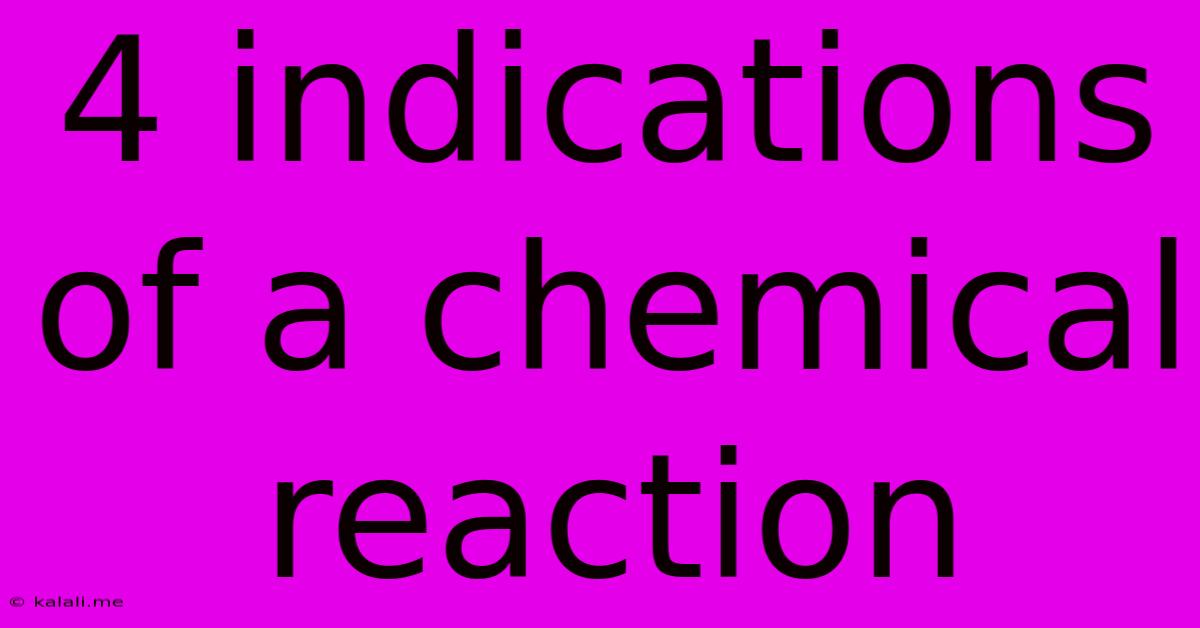4 Indications Of A Chemical Reaction
Kalali
May 09, 2025 · 4 min read

Table of Contents
4 Indications of a Chemical Reaction: A Beginner's Guide
Meta Description: Understanding chemical reactions is crucial in various fields. This article outlines four key indications that a chemical reaction is occurring, helping you identify these changes in everyday life and scientific experiments. Learn about color changes, gas production, precipitate formation, and temperature changes as evidence of chemical reactions.
Chemical reactions are the fundamental processes that shape our world, from the rusting of iron to the digestion of food. But how do we know a chemical reaction is actually happening? While some reactions are dramatic and obvious, others are subtle and require careful observation. This article will explore four key indicators that a chemical reaction is taking place.
1. A Change in Color
One of the most visually striking indications of a chemical reaction is a change in color. This occurs because the reactants are transforming into products with different chemical structures and, consequently, different abilities to absorb and reflect light. For instance, the gradual browning of an apple when exposed to air is a result of a chemical reaction involving oxygen and enzymes within the fruit. Similarly, the vibrant colors seen in fireworks are caused by chemical reactions producing light of specific wavelengths. Many chemical reactions involve colored reactants or products, providing a straightforward way to identify the occurrence of a reaction. This is especially useful in qualitative analysis where the visual color change helps identify unknown substances. The intensity of the color change can also provide information about the extent of the reaction.
2. Formation of a Gas
The production of gas is another clear sign of a chemical reaction. This gas might manifest as bubbles in a liquid, a fizzing sound, or a noticeable odor. The classic example is the reaction between baking soda (sodium bicarbonate) and vinegar (acetic acid), which produces carbon dioxide gas, causing the mixture to fizz. Other reactions might release gases like hydrogen, oxygen, or chlorine, each with its distinctive properties and safety considerations. The presence of a gas indicates that new chemical bonds are forming, leading to the release of gaseous products. Identifying the gas produced can also help in understanding the nature of the reaction. For example, the production of a flammable gas might point to a specific type of chemical transformation.
3. Formation of a Precipitate
A precipitate is a solid that forms from a solution during a chemical reaction. This solid is insoluble in the solution and separates out, often appearing as a cloudy substance or settling at the bottom of the container. For example, when solutions of lead(II) nitrate and potassium iodide are mixed, a yellow precipitate of lead(II) iodide forms. The formation of a precipitate is a strong indication that a chemical reaction has occurred, as the reactants have combined to form a new, insoluble compound. The properties of the precipitate, such as its color and solubility, can offer valuable insights into the reaction's products. Observing precipitate formation is frequently employed in analytical chemistry to identify unknown ions.
4. Change in Temperature
A change in temperature, either an increase (exothermic reaction) or a decrease (endothermic reaction), is another common indicator of a chemical reaction. Exothermic reactions release energy in the form of heat, causing a rise in temperature. Examples include combustion reactions like burning wood or the neutralization of an acid with a base. Endothermic reactions, on the other hand, absorb energy from their surroundings, leading to a decrease in temperature. Dissolving ammonium nitrate in water is a good example of an endothermic reaction. The temperature change provides evidence of energy transfer during the process of bond breaking and bond formation, crucial aspects of chemical reactions. Measuring the temperature change can also help quantify the energy involved in a particular reaction.
These four indicators—color change, gas production, precipitate formation, and temperature change—represent the most common signs of a chemical reaction. While not every reaction will exhibit all four, the presence of one or more is strong evidence that a chemical transformation has occurred. Observing these changes carefully is crucial for understanding the nature and extent of chemical reactions in various contexts, from everyday occurrences to complex scientific experiments.
Latest Posts
Latest Posts
-
Jaguar Adaptations In The Tropical Rainforest
May 10, 2025
-
How To Find Average Velocity From Velocity Time Graph
May 10, 2025
-
What Is Non Living Things In The Ecosystem
May 10, 2025
-
How Many Fl Oz In 6 Cups
May 10, 2025
-
What Is 1 Percent Of 5000
May 10, 2025
Related Post
Thank you for visiting our website which covers about 4 Indications Of A Chemical Reaction . We hope the information provided has been useful to you. Feel free to contact us if you have any questions or need further assistance. See you next time and don't miss to bookmark.